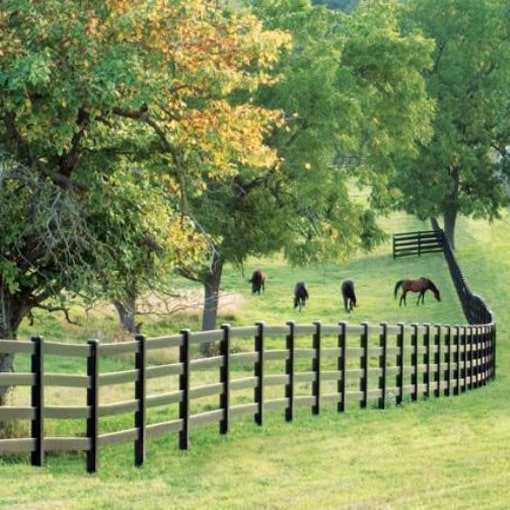As we strive for greener living and more environmentally friendly choices in every aspect of our lives, one area that might not immediately come to mind is the fencing surrounding our homes. Yet, the materials we choose for our fences can significantly impact the environment, from the production processes involved to their longevity and disposal. This blog explores the environmental benefits of choosing sustainable fencing materials, focusing on wood, vinyl, metal, and bamboo.
Defining Sustainable Fencing Materials
Sustainable fencing materials are characterized by their low environmental impact, both in terms of production and disposal, durability, and often, recyclability. They include renewable materials, like certain types of wood, recyclable materials, like certain plastics and metals, and materials with minimal environmental impact in production, like bamboo.
Wood: A Renewable and Biodegradable Choice
Wood is a classic and popular choice for fencing due to its natural appearance, versatility, and renewable nature. When sourced sustainably, wood fences can be environmentally friendly, as trees can be replanted and managed sustainably. The Forest Stewardship Council (FSC) certification is one way to ensure wood is sourced responsibly, reducing the impact on forests. Wood is biodegradable, meaning it won’t linger in landfills for centuries.
Vinyl Fencing: Durable and Recyclable
Vinyl fencing, made from PVC (polyvinyl chloride), offers a long-lasting, low-maintenance alternative to wood that can be recycled at the end of its lifespan. High-quality, recyclable vinyl is an important choice for those looking to minimize environmental impact, as it ensures the material can be reused, reducing the need for new resources.
Metal: The Sustainable Strength
Metal fences, particularly those made from steel or wrought iron, are celebrated for their durability, minimal maintenance needs, and recyclability. Steel, the primary component of many metal fences, has a global recycling rate of over 60%, making it a highly sustainable option. The metalworking industry increasingly focuses on sustainability, from using recycled materials to adopting energy-efficient manufacturing processes.
Bamboo: A Rapidly Renewable Resource
Bamboo stands out as an exceptionally sustainable fencing material due to its rapid growth rate and the fact that it’s a highly renewable resource. Bamboo can grow up to 3 feet per day, making it quickly replenishable. It’s also strong and durable, providing a practical, eco-friendly fencing option.
The Overall Environmental Benefits
Choosing sustainable fencing materials goes beyond reducing chemical treatments, minimizing landfill waste, and lowering the environmental impact of their production and disposal. These materials offer a range of additional benefits that are both environmentally significant and practically advantageous for homeowners.
Enhanced Durability and Reduced Maintenance
Sustainable materials like metal and bamboo offer exceptional durability. Metals such as aluminum and steel are recyclable and resistant to corrosion, pests, and weather conditions, making them a long-lasting option that rarely needs replacement. Similarly, bamboo is naturally resistant to pests and can withstand various weather conditions, outperforming many traditional materials in terms of longevity.
Carbon Sequestration
Bamboo, in particular, plays a crucial role in carbon sequestration. Its rapid growth rate enables it to absorb carbon dioxide from the atmosphere more efficiently than many tree species, acting as a carbon sink. This process helps mitigate climate change by reducing the overall concentration of CO2 in the atmosphere.
Energy Efficiency in Production
The production processes for sustainable fencing materials can be more energy-efficient than those for conventional materials. For example, recycling metals consumes considerably less energy than producing new metal from ore. This efficiency reduces greenhouse gas emissions associated with manufacturing.
Conservation of Natural Resources
Sustainable fencing materials contribute to the conservation of natural resources. Wood from responsibly managed forests minimizes deforestation and preserves ecosystems. Recycled metal and vinyl fences use existing materials, reducing the demand for virgin resources and the environmental degradation associated with their extraction and processing.
Reduction in Harmful Chemical Use
Sustainable fencing options often reduce the need for harmful chemical treatments. Unlike traditional wood fencing, which may require treatments with pesticides, preservatives, or sealants, many sustainable materials are naturally resistant to decay, pests, and weather. This reduction in chemical use benefits both human health and wildlife, decreasing the potential for soil and water contamination.
Aesthetic and Functional Versatility
Eco-friendly fencing materials offer aesthetic versatility without sacrificing environmental integrity. From the natural beauty of wood and bamboo to the sleek, modern appearance of metal and the variety of colors available in vinyl fencing, there’s a sustainable option to suit any design preference. Furthermore, these materials can often be customized to meet specific functional requirements like privacy, security, or noise reduction.
Positive Social Impact
Choosing sustainable fencing materials can also have a positive social impact. By supporting products certified for sustainability, consumers encourage responsible manufacturing practices and contribute to economic systems prioritizing environmental health, workers’ rights, and community well-being.
In conclusion, the benefits of choosing sustainable fencing materials extend far beyond their initial environmental advantages. These materials offer durability, energy efficiency, resource conservation, and a reduction in chemical use, all while providing homeowners with the versatility and aesthetic appeal they desire. By opting for sustainable fencing, individuals can significantly positively impact the environment, their own lives, and society at large.
Conclusion
The decision to opt for sustainable fencing materials is a significant step toward reducing our environmental footprint. By choosing wood from responsibly managed forests, recyclable vinyl, recyclable metals, or rapidly renewable bamboo, homeowners can enjoy their fences’ aesthetic and practical benefits without the environmental guilt. As we continue to push for sustainability in every aspect of our lives, let’s not overlook the impact of our choices in fencing materials. Opting for eco-friendly options protects our planet for future generations, proving that every small choice can contribute to a larger environmental solution.
Read More:

